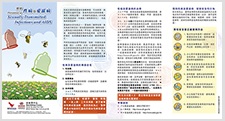Pamphlet
Prevention of Sexually Transmitted Infections and AIDS
Download PDF file of the bilingual pamphlet for printing
Download PDF file of other languages for printing
Bengali | French | Hindi | Indonesian | Nepali | Simplified Chinese | Tagalog | Thai | Urdu | Vietnamese | Sinhala
 Sexually Transmitted Infections (STIs) primarily spread through direct sexual contact. They are commonly caused by bacteria, viruses or parasites. In Hong Kong, the commonest STIs are syphilis, gonorrhoea, non-gonococcal urethritis/ non-specific genital tract infection, genital wart, herpes genitalis, and pubic lice. AIDS (Acquired Immunodeficiency Syndrome), being one of the STIs, is caused by the virus HIV (Human Immunodeficiency Virus). After entering human body, HIV will gradually destroy the patient’s immune system, causing various diseases such as cancer and opportunistic infections, and finally lead to death. Different STIs can present in different ways. Itchiness over the genitalia, broken skin, small growth, blisters, painful or frequent urination, and unusual discharge from the penis or vagina are all common symptoms. Some STIs, however, do not develop any symptom at all, making people difficult to know their infected status. For example, people infected with HIV can have no symptoms in the first few years, yet continue to spread the virus to other people. Transmission routes of STIs and AIDS
STIs and AIDS cannot be transmitted through social contacts such as shaking hands, hugging, kissing cheeks, going to school and working together and sharing meals. Up till now, no medical evidence has shown insect bites can transmit STIs or AIDS. Treatment for STIs and AIDS STIs can increase a person's risk of HIV infection and cause other serious health consequences, e.g. infertility, congenital abnormalities or even death. Nowadays, some STIs can be cured with medication such as antibiotics. To avoid re-infection, your sexual partners should also receive check-up and treatment. You should refrain from sex or practise safer sex when under treatment to avoid spreading the virus. Please comply with doctor’s instruction to complete the whole course of treatment for the best result. To ensure complete cure or the infection is well controlled, please follow your doctor’s or clinic’s advice to continue follow-up even you have no more symptoms. If you think you have STI, please consult your doctor for early diagnosis and treatment. The social hygiene clinics of the Department of Health provides testing, treatment and counselling on STIs. All information is kept confidential. Neither advanced booking nor doctor's referral letter is required. For detail, please visit the Department of Health’s website: http://www.dh.gov.hk. OR you should consult a registered medical practitioner. Please DON’T self-medicate as it may delay effective treatment and worsen the condition. Although cure for AIDS is not yet available, antiretroviral therapy can effectively control the infection by suppressing HIV in the human body and slowing down damages to the immune system. Other drugs are also available to prevent or treat opportunistic infections and other complications. This helps the HIV infected people to enjoy a longer life with good quality. As with other diseases, early diagnosis and early treatment can prevent the condition from worsening. If you suspect you might have HIV infection, do consult doctors and ask for an HIV test as soon as possible. You may call the AIDS Hotline of the Department of Health: (852) 2780 2211 for a free and anonymous HIV testing. All information is kept confidential. Sexually active persons should have regular check up and HIV testing To prevent STIs and AIDS, practise safer sex The most effective way of preventing STIs and AIDS is to use condom properly for each sexual contact. Sex without exchange of body fluids such as kissing cheeks, masturbation, mutual caressing have a lower risk of STIs and HIV infection. Proper use of male condom
Related information AIDS Hotline of the Department of Health:〈852〉2780 2211 Red Ribbon Centre Tel: (852) 3143 7200 Produced by Red Ribbon Centre – UNAIDS Collaborating Centre for Technical Support, Hong Kong
|
